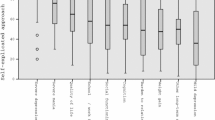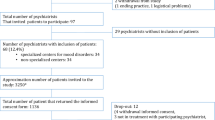Abstract
The staff of the American Psychiatric Assocition (APA), the American Psychiatric Institute for Research and Education (APIRE), and a national panel of experts in bipolar disorder and practice guideline development have collaborated to generate a set of quality of care indicators for the pharmacologic and psychosocial treatment of bipolar disorder. The indicators were derived from APA’s evidence-based Practice Guideline for the Treatment of Patients with Bipolar Disorder, 2002 (1) and the Expert Consensus Guideline Series: Medication Treatment of Bipolar Disorder, 2000 (2) These quality indicators can be used for quality monitoring, benchmarking, and quality improvement efforts across health plans, systems of care, and health care providers to improve quality and outcomes of care for patients with bipolar disorder.
Similar content being viewed by others
References
American Psychiatric Association: Practice Guidelines for the Treatment of Patients with Bipolar Disorder (Revision). Washington, DC, American Psychiatric Association, 2002.American Psychiatric Association: Practice Guidelines for the Treatment of Patients with Bipolar Disorder (Revision). Washington, DC, American Psychiatric Association, 2002.
Sachs GS, Printz DJ, Kahn DA, et al: The Expert Consensus Guideline Series: Medication Treatment of Bipolar Disorder. A Post Graduate Medicine Special Report, McGraw-Hill, 2000.
Diagnostic and Statistical Manual of Mental Disorders, 4th ed. Washington, DC, American Psychiatric Association, 1994.
Narrow WE, Rae DS, Robins LN, et al: Revised prevalence estimates of mental disorders in the United States: Using a clinical significance criterion to reconcile 2 surveys’ estimates. Archives of General Psychiatry 59:115–23, 2002.
Murray CJ, Lopez AD, (eds): The Global Burden of Disease: A Comprehensive Assessment of Mortality and Disability from Diseases, Injuries, and Risk Factors in 1990 and Projected to 2020. World Health Organization. Cambridge (MA): Harvard University Press, 1996.
Regier DA, Narrow WE, Rae DS, et al: The de facto mental and addictive service system: Epidemiologic catchment area prospective 1-year prevalence rates of disorders and services. Archives of General Psychiatry 50:85–94, 1993.
Narrow WE, Regier DA, Rae DS, et al: Use of services by persons with mental and addictive disorders: Findings from the National Institute of Mental Health Epidemiologic Catchment Area Program. Archives of General Psychiatry 50:95–107, 1993.
Begley CE, Annegers JF, Swann AC, et al: The Lifetime Cost of Bipolar Disorder in the US: An estimate for new cases in 1998. Pharmacoeconomics 19:483–495, 2001.
Wyatt RJ, Henter I: An economic evaluation of manic-depressive illness. Social Psychiatry Psychiatr. Epidemiol 30:213–219, 1995.
Zarin DA, Seigle BA, Pincus HA, et al: Evidence-based practice guidelines. Psychopharmacology Bulletin 33:641–646, 1997.
Dickey B, Sederer LI (eds): Improving Mental Health Care: Commitment to Quality. Washington, DC, American Psychiatric Publishing, 2001.
McIntyre JS, Zarin DA, Pincus HA: Practice guidelines in psychiatry and a Psychiatric Practice Research Network, in Psychiatry in the New Millennium. Edited by Weissman SH, Sabshin MS, and Eist H. Washington, DC, American Psychiatric Press, 1999.
Rush AJ, Crismon ML, Toprac MG, et al: Consensus guidelines in the treatment of major depressive disorder. Journal of Clinical Psychiatry 59:73–84, 1998.
West JC, Das A, Zarin DA, et al: Treatment of Bipolar Disorder in Routine Practice. The National Institute of Mental Health NCDEU Annual Meeting, Phoenix, AZ, June 2001.
Blanco C, Laje G, Olfson M, et al: Trends in the treatment of bipolar disorder by outpatient psychiatrists. American Journal of Psychiatry 159:1005–1010, 2002.
Unutzer J, Simon G, Pabiniak C, et al: The use of administrative data to assess quality of care for bipolar disorder in a large staff model HMO. General Hospital Psychiatry 22:1–10, 2000.
Levine J, Chengappa KN, Brar JS, et al: Psychotropic drug prescription patterns among patients with bipolar I disorder. Bipolar Disorder 2:120–130, 2000.
Sachs G, Lafer B, Truman CJ, et al: Lithium Monotherapy: Miracle, myth and misunderstanding. Psychiatric Annals 24:299–306, 1994.
Lim PZ, Tunis SL, Edell WS, et al: Medication prescribing patterns for patients with bipolar I disorder in hospital settings: Adherence to published practice guidelines. Bipolar Disorder 3:165–173, 2001.
Lohr KN (ed): Medicare: A Strategy for Quality Assurance. Washington, DC, National Academy Press, 1990.
Report of the APA Task Force on Quality Indicators and report of the APA Task Force on Quality Indicators for Children: Quality indicators: defining and measuring quality in psychiatric care for adults and children. Washington DC, American Psychiatric Association, 2002.
Eddy DM: Practice policies: Where to they come from? JAMA 263:1265, 1269, 1272, 1990.
McIntyre D, Rogers L, Heier EJ: Overview, history, and objectives of performance measurement. Health Care Financing Review 22:7–21, 2001.
Visit http://mentalhealth.samhsa.gov/publications/allpubs/KEN95-0023/.
Manderscheid RW, Henderson MJ (eds): Center for Mental Health Services. Mental Health, United States, 2000. Washington, DC: Department of Health and Human Services (US), Supt. of Docs., U.S. Government Print Office, Publication No. (SMA) 01-3537, 2001.
McGlynn EA, Asch SM: Developing a clinical performance measure. American Journal of Preventative Medicine 14:14–21, 1998.
Bronstein JM, Santer L, Johnson V: The use of Medicaid claims as a supplementary source of information on quality of asthma care. Journal of Healthcare Quality 22:13–18, 2000.
Steinwachs DM, Stuart ME, Scholle S, et al: A comparison of ambulatory Medicaid claims to medical records: A reliability assessment. American Journal of Medical Quality 13:63–69, 1998.
Cradock J, Young AS, Sullivan G: The accuracy of medical record documentation in schizophrenia. Journal of Behavioral Health Services Research 28:456–465, 2001.
West JC, Leaf PL, Zarin DA: Health plan characteristics and conformance with key practice guideline psychopharmacologic treatment recommendations for major depression. Mental Health Services Research Journal 2(4):223–237, 2000.
West JC, Olfson M, Narrow NE, et al: Treatment of Schizophrenia in Routine Psychiatric Practice; The American Psychiatric Association Annual Meeting, San Francisco, California, 2003.
Zarin DA, Suarez AP, Pincus HA, Kupersanin E, Zito JM: Clinical and treatment characteristics of children with attention-deficit/hyperactivity disorder in psychiatric practice. Journal of the American Academy of Child and Adolescent Psychiatry 37:1262–1270, 1998.
Stewart RE, Vroegop S, Kamps GB, et al: Factors influencing adherence to guidelines in general practice. International Journal of Technology Assessment in Health Care 19:546–554, 2003.
Pedone C, Lapane KL: Generalizability of guidelines and physicians’ adherence. Case study on the Sixth Joint National Commitee’s guidelines on hypertension. BioMed Central Public Health 3:24, 2003.
Bussing R, Gary FA: Practice guidelines and parental ADHD treatment evaluations: Friends or foes? Harvard Review of Psychiatry 9:223–233, 2001.
Rose D, Fleischmann P, Wykes T, Leese M, Bindman J: Patients’ perspectives on electroconvulsive therapy: Systematic review, British Medical Journal 326:1363, 2003.
Koopowitz LF, Chur-Hansen A, Reid S, Blashki M: The subjective experience of patients who received electroconvulsive therapy. Australian and New Zealand Journal of Psychiatry 37(1):49–54, 2003.
Devanand DP, Dwork AJ, Hutchinson ER, et al: Does ECT alter brain structure? American Journal of Psychiatry 151:957–970, 1994.
A Task Force Report of the American Psychiatric Association on the Practice of Electroconvulsive Therapy: Recommendations for Treatment, Training, and Privileging (2nd ed.) The American Psychiatric Association, Washington DC, 2001.
Hlatky MA: Patient preferences and clinical guidelines. JAMA 273:1185–1190, 1995.
Cabana MD, Rand CS, Powe NR, et al: Why don’t physicians follow clinical practice guidelines? A framework for improvement. JAMA 282:1458–1465, 1999.
Davis DA, Taylor-Vaisey A: Translating guidelines into practice. A systematic review of theoretic concepts, practical experience and research evidence in the adoption of clinical practice guidelines. CMAJ 157:408–416, 1997.
Tonelli MR: The philosophical limits of evidence-based medicine. Academic Medicine 73:1234–1240, 1998.
Huskamp HA: Managing psychotropic drug cost: Will formularies work? Health Affairs 22:84–96, 2003.
West JC, Pingitore D, Zarin DA: Characteristics of psychiatric patients for whom financial considerations affect the provision of treatments. Psychiatric Services 53:1626–1629, 2002.
Busch SH: Specialty health care, treatment patterns, and quality: The impact of a mental health carve out on care for depression; Health Services Research 37:1583–1601, 2002.
Frank RG, Huskamp HA, Pincus HA: Aligning incentives in the treatment of depression in primary care with evidence-based practice. Psychiatric Services 54:682–687, 2003.
Chassin MR: Is health care ready for six sigma quality? Milbank Quarterly 76:565–591, 1998.
Author information
Authors and Affiliations
Rights and permissions
About this article
Cite this article
Duffy, F.F., Narrow, W., West, J.C. et al. Quality of Care Measures for the Treatment of Bipolar Disorder. Psychiatr Q 76, 213–230 (2005). https://doi.org/10.1007/s11126-005-2975-4
Issue Date:
DOI: https://doi.org/10.1007/s11126-005-2975-4




